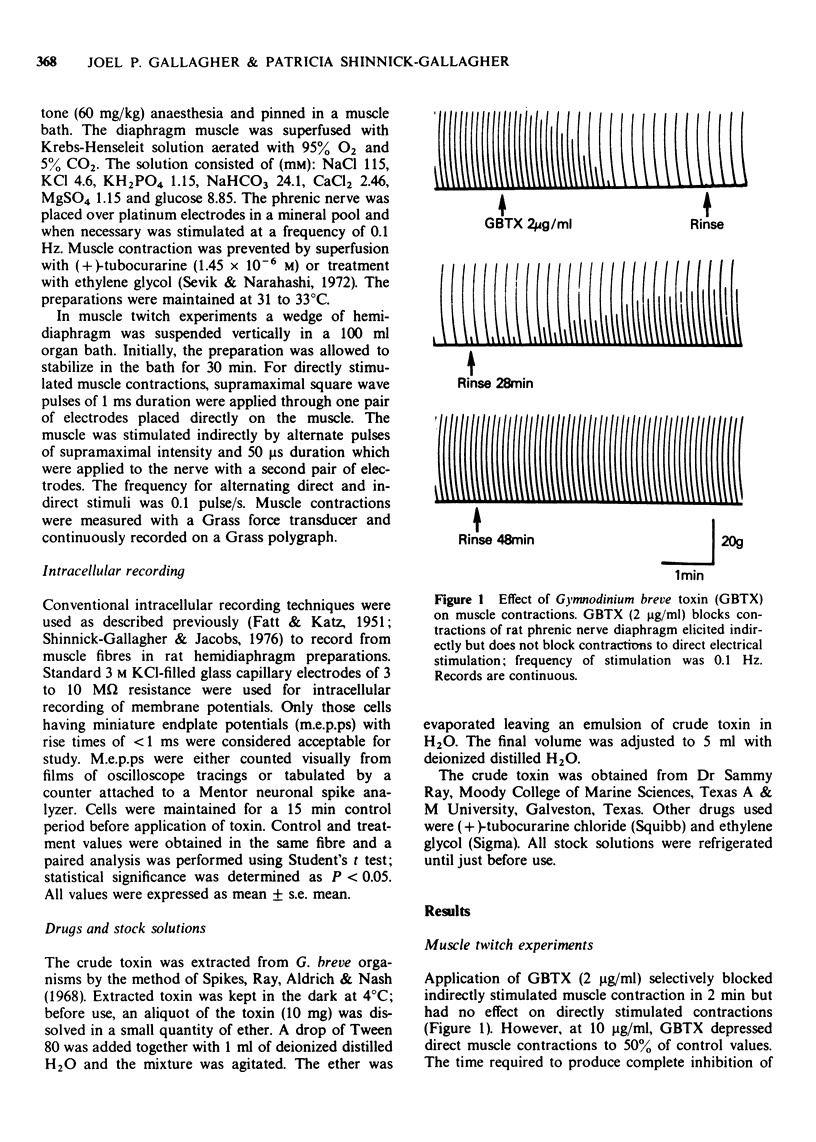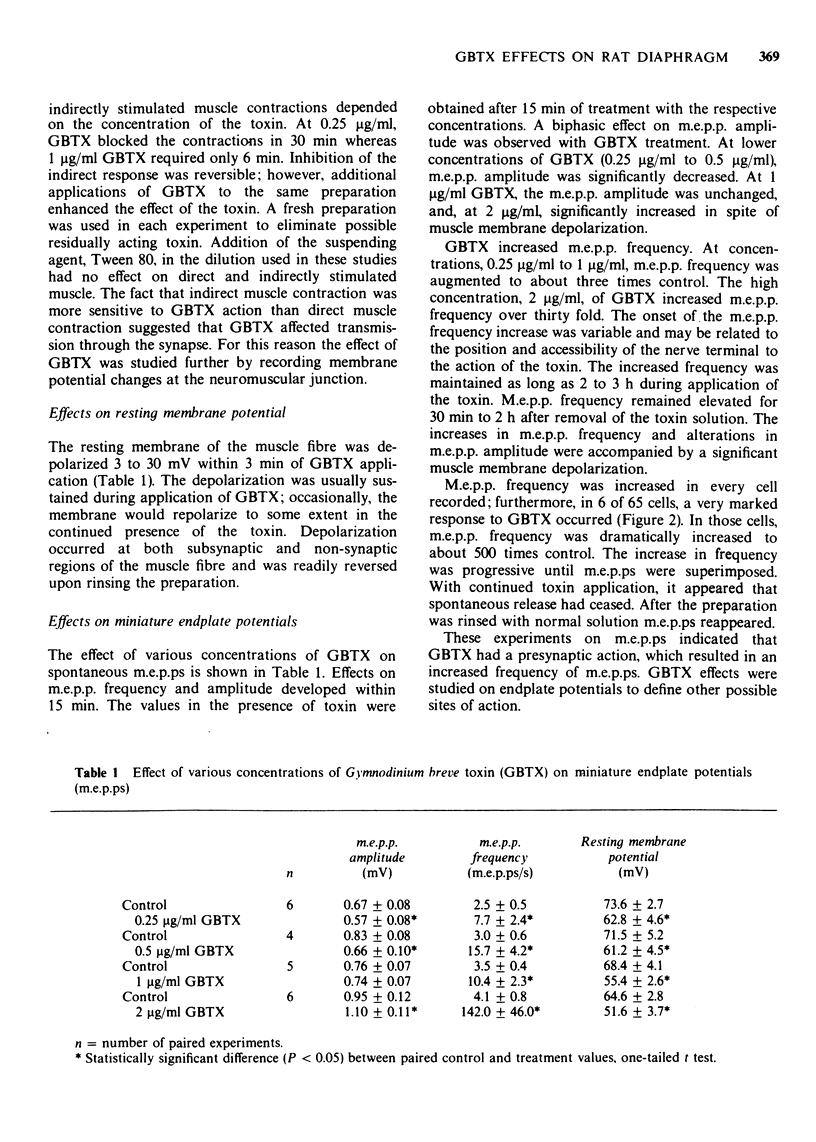Abstract
1 The effects of a crude fraction of Gymnodinium breve toxin (GBTX) were studied on the rat phrenic nerve diaphragm preparation. 2 Indirectly stimulated muscle contractions were more sensitive to blockade by increasing concentrations of GBTX (0.25 microgram/ml to 10 micrograms/ml) than direct muscle contractions. 3 GBTX increased miniature endplate potential (m.e.p.p.) frequency and depolarized the resting membrane potential of the muscle fibres at the endplate and in non-synaptic regions of muscle fibre. 4 A concentration-dependent biphasic effect on m.e.p.p. amplitude was evident. At lower concentrations m.e.p.p. amplitudes were depressed whereas at high concentrations they were increased. 5 GBTX blocked endplate potentials (e.p.ps) in concentrations (0.5 microgram/ml to 2 micrograms/ml) that did not block m.e.p.ps. 6 Muscle fibre action potentials recorded from cells held at control membrane potential by hyperpolarizing current were not altered by toxin treatment. No repetitive e.p.ps, or muscle action potentials were observed. 7 These data suggest that GBTX may block indirectly stimulated muscle contractions and e.p.ps by depolarizing the nerve terminal in a manner similar to the observed depolarization of the muscle fibre. The depolarization of the nerve terminal may be sufficient to inhibit transmitter release.
Full text
PDF





Selected References
These references are in PubMed. This may not be the complete list of references from this article.
- FATT P., KATZ B. An analysis of the end-plate potential recorded with an intracellular electrode. J Physiol. 1951 Nov 28;115(3):320–370. doi: 10.1113/jphysiol.1951.sp004675. [DOI] [PMC free article] [PubMed] [Google Scholar]
- Hubbard J. I., Willis W. D. The effects of depolarization of motor nerve terminals upon the release of transmitter by nerve impulses. J Physiol. 1968 Feb;194(2):381–405. doi: 10.1113/jphysiol.1968.sp008414. [DOI] [PMC free article] [PubMed] [Google Scholar]
- KRNJEVIC K., MILEDI R. Failure of neuromuscular propagation in rats. J Physiol. 1958 Mar 11;140(3):440–461. [PMC free article] [PubMed] [Google Scholar]
- McFarren E. F., Silva F. J., Tanabe H., Wilson W. B., Campbell J. E., Lewis K. H. The occurrence of a ciguatera-like poison in oysters, clams, and Gymnodinium breve cultures. Toxicon. 1965 Nov;3(2):111–123. doi: 10.1016/0041-0101(65)90005-x. [DOI] [PubMed] [Google Scholar]
- Music S. I., Howell J. T., Brumback C. L. Red tide. Its public health implications. JFMA. 1973 Nov;60(11):27–29. [PubMed] [Google Scholar]
- Sasner J. J., Jr, Ikawa M., Thurberg F., Alam M. Physiological and chemical studies on Gymnodinium breve Davis toxin. Toxicon. 1972 Mar;10(2):163–172. doi: 10.1016/0041-0101(72)90242-5. [DOI] [PubMed] [Google Scholar]
- Sevcik C., Narahashi T. Electrical properties and excitation-contraction coupling in skeletal muscle treated with ethylene glycol. J Gen Physiol. 1972 Aug;60(2):221–236. doi: 10.1085/jgp.60.2.221. [DOI] [PMC free article] [PubMed] [Google Scholar]
- Shinnick-Gallagher P., Jacobs R. S. An analysis of the subsynaptic site of action of theophylline on isolated cat tenuissimus muscle. J Pharmacol Exp Ther. 1976 Jun;197(3):647–652. [PubMed] [Google Scholar]
- Shinnick-Gallagher P. Possible mechanisms of action of Gymnodinium breve toxin at the mammalian neuromuscular junction. Br J Pharmacol. 1980 Jul;69(3):373–378. doi: 10.1111/j.1476-5381.1980.tb07024.x. [DOI] [PMC free article] [PubMed] [Google Scholar]
- Spikes J. J., Ray S. M., Aldrich D. V., Nash J. B. Toxicity variations of Gymnodinium breve cultures. Toxicon. 1968 Feb;5(3):171–174. doi: 10.1016/0041-0101(68)90085-8. [DOI] [PubMed] [Google Scholar]
- Westerfield M., Moore J. W., Kim Y. S., Padilla G. M. How Gymnodinium breve red tide toxin(s) produces repetitive firing in squid axons. Am J Physiol. 1977 Jan;232(1):C23–C29. doi: 10.1152/ajpcell.1977.232.1.C23. [DOI] [PubMed] [Google Scholar]


